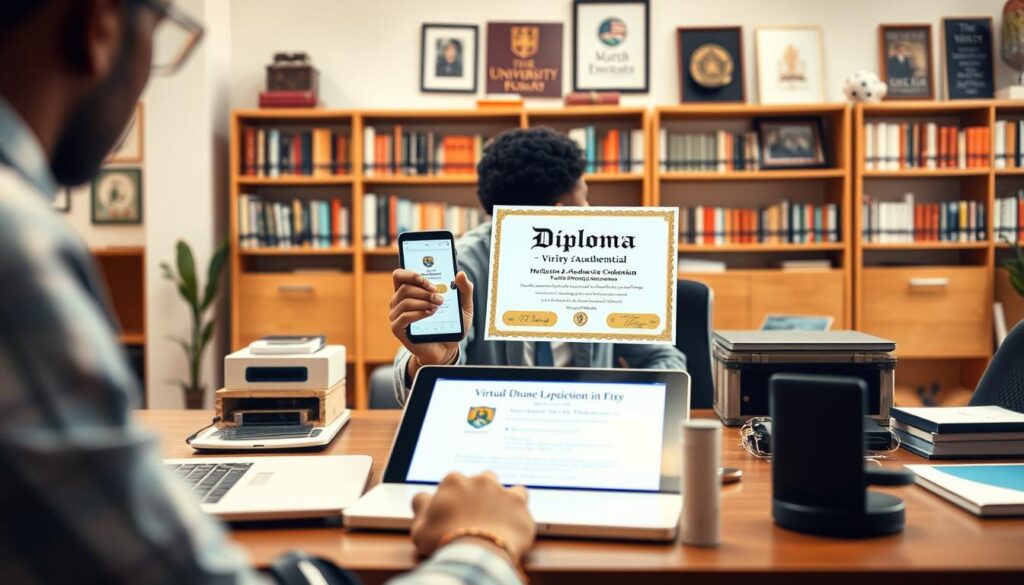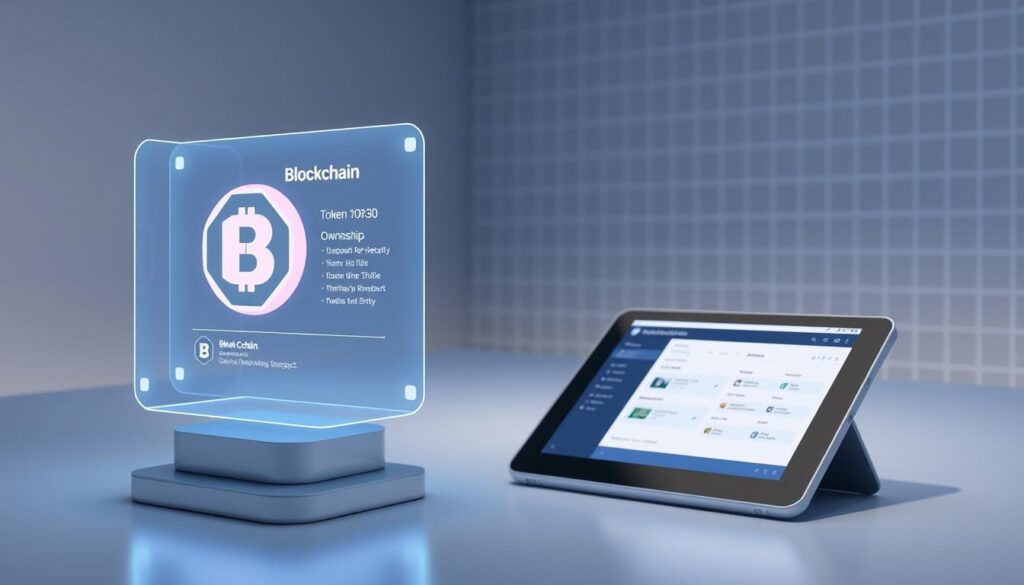Now Reading: Understanding NFT Diploma Educational Credential Verification
- 01
Understanding NFT Diploma Educational Credential Verification
Understanding NFT Diploma Educational Credential Verification

The world of academic qualifications is undergoing a profound transformation. Traditional paper-based systems are making way for more secure and efficient digital solutions. At the heart of this change lies a powerful combination of technologies designed to protect the value of hard-earned achievements.
This new approach leverages the unique properties of blockchain. This technology creates a permanent, unchangeable record. Each academic award becomes a distinct digital asset, impossible to counterfeit or lose. This offers a significant advantage in today’s global job market.
For graduates, this means having lifelong access to their qualifications. They can share them with employers or institutions instantly and securely. For organisations, it simplifies the process of checking an individual’s background, reducing fraud. This innovation represents a fundamental shift in how we manage and trust academic records. You can explore how this technology is revolutionising the entire in more detail.
Key Takeaways
- Traditional paper credentials are being replaced by secure digital versions.
- Blockchain technology ensures that each digital record is unique and cannot be tampered with.
- This system gives individuals full control over their academic achievements.
- Employers benefit from a faster and more reliable way to verify qualifications.
- The technology helps to combat fraud from fake degrees and diploma mills.
- It represents a major step forward for trust and efficiency in the education sector.
Introduction: Revolutionising Credential Verification in Education
A quiet revolution is underway in how we document and trust scholastic accomplishments globally. Traditional paper-based systems are being replaced by innovative digital solutions that address longstanding challenges.
Changing Dynamics in Academic Credentialing
The academic landscape is transforming rapidly. Institutions now recognise the need for modern systems that meet today’s demands. Digital solutions offer significant advantages over older methods.
This shift reflects broader technological progress across sectors. The table below highlights key differences between traditional and modern approaches:
| Aspect | Traditional Paper Systems | Modern Digital Solutions |
|---|---|---|
| Security Level | Vulnerable to forgery | Enhanced protection features |
| Access Speed | Days or weeks for verification | Instant confirmation available |
| Global Access | Physical transfer required | Worldwide instant sharing |
| Fraud Prevention | Limited authentication methods | Advanced verification protocols |
The Importance of Secure, Digital Credentials
Secure digital records protect against identity theft and fraudulent claims. They give individuals control over their academic achievements. This builds trust between all parties involved.
Employers benefit from reliable confirmation processes. Students gain portable, lifelong access to their qualifications. The entire ecosystem becomes more efficient and transparent.
The Evolution of Digital Credentials in Academia
Academic record-keeping has journeyed through significant technological milestones over recent decades. The shift from physical documents to digital systems represents a fundamental change in how we manage scholastic achievements.
Traditional versus Digital Verification Methods
Traditional approaches to confirming academic achievements involved lengthy processes. Institutions relied on phone calls, postal mail, and manual searches through archives. These methods could take days or even weeks to complete.
The digital revolution introduced new verification techniques. Early digital systems used PDF certificates and centralised databases. While faster than paper-based systems, they still faced security challenges.
Blockchain technology has transformed the landscape completely. This innovative method creates permanent, tamper-proof records. The verification process now happens almost instantly.
Modern systems combine the best aspects of digital convenience with robust security. They offer permanent record-keeping and global accessibility. This represents a revolutionary advancement in academic administration.
Step-by-Step NFT Diploma Educational Credential Verification Process
The transformation of academic records into secure digital assets follows a clear, step-by-step procedure. This systematic approach ensures each qualification becomes a permanent, trustworthy digital record.
Understanding the Tokenisation Process
Tokenisation converts traditional paper certificates into unique digital tokens. This innovative process encodes achievement details into a special digital format. The encoded information includes course specifics, issuing institution, and recipient details.
Each token receives a unique identifier that links to specific achievement data. This makes mathematical duplication or forgery impossible after issuance. The entire system operates on decentralised blockchain technology.
Smart contracts automate the issuance and management of these digital tokens. They handle access permissions and ensure consistent verification protocols. This automation eliminates human error and speeds up the entire process.
Employers can verify qualifications instantly through simple links or QR codes. They access the blockchain to confirm legitimacy without contacting the original institution. The verification process requires no specialised technical knowledge.
Sensitive personal data remains protected through advanced encryption. Authorised parties can still verify achievement details while maintaining privacy. This balance between accessibility and security represents a major advancement.
Harnessing Blockchain Technology for Academic Security
Academic integrity finds its strongest ally in the cryptographic foundations that underpin blockchain systems. This innovative approach to data protection represents a significant advancement over traditional methods.

Decentralised Data Storage and Integrity
Blockchain technology operates on a distributed network architecture. Instead of relying on central servers, information spreads across multiple computers. This eliminates single points of failure that hackers often target.
Each piece of data receives a unique cryptographic hash. This digital fingerprint makes tampering immediately detectable. Any alteration changes the hash value and breaks the verification chain.
The immutable ledger technology ensures records remain permanently secure. Changing one block requires recalculating all subsequent blocks across the entire network. This computational impracticality provides unprecedented protection against fraud.
| Security Feature | Traditional Systems | Blockchain Technology |
|---|---|---|
| Data Storage | Centralised servers | Distributed network nodes |
| Tamper Resistance | Limited protection | Cryptographic hashing |
| Verification Process | Manual checks required | Automated consensus |
| Fraud Prevention | Reactive measures | Proactive architecture |
Transparency mechanisms allow authorised parties to audit transactions without compromising privacy. The distributed consensus model creates a trustless environment where security doesn’t depend on any single entity.
Exploring the Key Benefits of NFT Credentials
Beyond mere digitisation, the core advantages of this new system lie in its profound benefits for security and user control. These tokenised records offer a significant upgrade for everyone involved.
For graduates, the permanent access to their qualifications is a game-changer. They hold their verified achievements in a personal digital wallet. This eliminates reliance on institutional archives and fees for official transcripts.
Employers gain from an instant confirmation process. Checking a candidate’s background shifts from a days-long task to a matter of seconds. This speeds up hiring and reduces the risk of fraud.
Issuing universities also see major improvements. The immutable nature of blockchain protects their reputation. It ensures that awards cannot be forged after they are issued.
| Stakeholder | Key Benefit | Practical Impact |
|---|---|---|
| Students & Graduates | Lifelong Ownership & Control | Share qualifications instantly, anywhere in the world. |
| Employers | Speed and Trust in Verification | Make confident hiring decisions with real-time checks. |
| Educational Institutions | Enhanced Security and Efficiency | Reduce administrative costs and combat credential fraud. |
These combined advantages create a more transparent and efficient ecosystem. Global mobility is simplified as qualifications are recognised across borders without complex re-verification. This represents a powerful step forward for academic recognition.
Digital Issuance of Diplomas: Process and Advantages
The administrative process of awarding scholastic achievements is being fundamentally reimagined through digital innovation. Universities are adopting systems that transform traditional paperwork into secure digital assets.

Streamlined Issuance and Reduced Fraud
Digital creation eliminates the complex steps of physical certificate production. Institutions bypass printing, embossing, and postal distribution entirely. This creates significant time and cost savings.
The technology provides robust protection against fraudulent practices. Each digital award contains unique identifiers that prevent forgery. Unauthorised reproduction becomes mathematically impossible after issuance.
Instant Sharing and Verification Features
Graduates gain immediate control over their achievements. They can share verified qualifications through simple digital links. This eliminates requests for official transcripts and associated fees.
Employers benefit from real-time authentication capabilities. They access blockchain records directly rather than contacting registrar offices. The verification process happens in seconds instead of days.
Platforms like BCdiploma demonstrate how technical implementation has been simplified. Institutions can issue thousands of secure awards with minimal infrastructure investment. This represents a complete rethinking of the credential lifecycle.
Implementing Secure Digital Badges in Education
The educational landscape is embracing a new layer of recognition through secure digital badges. These tokens represent specific skills and accomplishments beyond a full degree. They offer verifiable proof for course completions, workshop attendance, and micro-credentials.
Earlier digital badge systems faced credibility issues. Badges could be easily copied or claimed without being earned. Blockchain technology solves this by creating a unique, tamper-proof record for each award.
Specialised platforms help institutions create and manage these systems. They integrate distributed ledger technology to build internationally recognised systems. This allows badges from one organisation to be trusted by employers everywhere.
| Feature | Early Digital Badges | Blockchain-Based Badges |
|---|---|---|
| Authenticity | Easy to copy or falsify | Unique, cryptographic proof |
| Verification | Relies on issuer’s database | Decentralised, instant check |
| Portability | Limited to specific platforms | Global accessibility and sharing |
| Value to Learners | Low due to fraud risk | High, trusted by employers |
Learners can build a unified portfolio from multiple sources. This provides a comprehensive view of their capabilities. The transparency of the system allows anyone to see a badge’s full history, including the issuing authority and earning criteria.
This approach motivates learners by recognising incremental progress. It also gives employers detailed, skills-specific information. For a deeper look at this evolution, see this comparison of digital and traditional systems.
Decentralised Diplomas: Transforming Verification Methods
The shift towards decentralised academic awards marks a pivotal moment for data ownership. This approach fundamentally alters how we confirm achievements by distributing control.
Instead of relying on a single institution’s database, records are spread across a secure network. This architecture eliminates the risk of records being lost if a server fails or an organisation closes.

Enhanced Security and Accessibility
This distributed system offers superior protection. To compromise a record, an attacker would need to target multiple network points simultaneously, which is practically impossible.
Graduates gain permanent, direct access to their qualifications. They can share them instantly with employers without needing a third party to confirm their validity.
This supports lifelong learning, allowing individuals to build a portable portfolio of achievements. It places control firmly in the hands of the learner, aligning with modern goals of data sovereignty.
Blockchain Strategies for Ensuring Data Authenticity
Mathematical principles, rather than institutional reputation, are becoming the bedrock of trust for academic awards. This shift is powered by sophisticated strategies within blockchain technology that guarantee the authenticity of information with unprecedented certainty.
Immutable Ledgers for Academic Records
The core of this security is the immutable ledger. Once a record is added to the chain, it cannot be changed or deleted. Each new block of data contains a unique cryptographic hash, linking it securely to the previous block.
This creates a chronological chain. Any attempt to alter historical records would break this chain. The entire network would instantly detect the discrepancy, making falsification mathematically impossible.
Distributed consensus is another key strategy. Before a new record is accepted, multiple independent nodes on the network must verify it. This process eliminates the risk of a single point of failure or manipulation.
Timestamping mechanisms provide an additional layer of security. They create a verifiable, unchangeable record of when an achievement was issued. This prevents backdated or fraudulent claims.
Finally, the blockchain‘s transparent architecture allows for secure auditing. Authorised parties can verify the issuance and history of an award while personal details remain protected. Together, these strategies build a system where trust is automatic and built-in.
Technical Considerations and Digital Wallet Management
A significant technical hurdle in adopting blockchain-based academic awards was the requirement for complex digital wallets. Expecting all learners to manage specialised cryptocurrency wallets created a major barrier to widespread use.
Innovative platforms have solved this problem with user-friendly solutions. They allow students to access their digital assets using a simple email address.
User-Friendly Solutions for Credential Access
Services like mywallet.cloud provide a custodial application designed specifically for academic use. This technology acts as a transparent wallet in the background. Students can use this service without any knowledge of blockchain.
The application supports standard formats like Open Badges. This lets learners store all their achievements from different institutions in one place.
For those who prefer it, the system also supports interoperability. Students can still choose to use their own Web3 wallet to receive and manage their assets. This flexibility ensures the technology meets diverse user needs.
The key is that the sophisticated technology remains invisible. The user experience is simple and intuitive, encouraging broad adoption.
Overcoming Barriers in NFT Credential Adoption
Despite the clear advantages, several significant hurdles have slowed the widespread acceptance of this new system. These challenges range from technical complexity to user apprehension. Understanding these barriers is the first step towards solving them.
Addressing Security and User Experience Concerns
Early implementations faced real challenges. Setting up a system for Verifiable Credentials is complex. It involves managing registries and choosing formats like Decentralised Identifiers (DIDs).
Security and privacy were major concerns. Solutions now often link these digital assets to non-transferable identity objects. This maintains the proof of personal achievement, a point highlighted by innovators like Vitalik Buterin.
For students and institutions, the user experience was a big barrier. Complex wallets and technical jargon created friction. Modern platforms have simplified this greatly.
| Historical Barrier | Modern Solution |
|---|---|
| Technical Complexity | Simplified, user-friendly platforms for issuance and management. |
| Security Worries | Advanced encryption and privacy-preserving verification methods. |
| Poor User Experience | Intuitive interfaces that hide the underlying technology. |
| Lack of Standards | Emerging industry standards that ensure interoperability. |
Regulatory compliance was another hurdle. Institutions needed systems that met data protection laws. New frameworks now ensure GDPR and FERPA compliance is built-in.
The implementation process is becoming more straightforward. This addresses budget and training concerns. The path to adoption is now clearer than ever.
Real-World Applications and Case Studies of NFT Diplomas
Concrete evidence now demonstrates the global adoption of blockchain-based academic awards across diverse learning environments. Over 170 institutions worldwide have embraced this technology, issuing more than 100,000 digital records in 2024 alone.

Prestigious universities associated with Cambridge and Oxford have implemented blockchain services to ensure award authenticity. These implementations show how organisations are moving beyond pilot projects to full-scale deployment.
Examples from Leading Institutions
Different types of learning organisations have adopted this approach. Large research universities issue tens of thousands of credentials annually. Specialised training programmes and professional certification bodies also use the technology.
The Binance Crypto Academy represents innovative applications in emerging fields. They issue Web3 digital credentials as part of their real-world implementation strategy.
| Institution Type | Implementation Scale | Key Benefit Achieved |
|---|---|---|
| Research Universities | Tens of thousands of credentials | Enhanced global recognition |
| Professional Certifiers | Specialised programmes | Reduced verification costs |
| Online Education | Diverse course offerings | Improved fraud protection |
Platforms like eGAB report that implementation increases institutional competitiveness by approximately 20%. Students benefit from portable, lifelong access to their achievements.
These case studies provide valuable best practices for other organisations. They demonstrate successful integration with existing systems and measurable outcomes.
Optimising Verification Processes for Educational Institutions
Modern technology offers academic bodies powerful tools to transform their confirmation processes. Traditional methods often involve lengthy background checks and manual communication between multiple parties. These approaches are prone to errors and consume significant resources.
Blockchain-based systems enable almost instantaneous authentication. Relevant details are readily available and checkable on the distributed ledger. Employers or other organisations can confirm legitimacy by accessing the blockchain directly.
This approach provides substantial benefits. Institutions experience reduced administrative costs and faster response times. Accuracy improves significantly, eliminating human error from the equation.
Integration with existing student information systems allows seamless implementation. Organisations can maintain compatibility with established workflows while adopting new capabilities. This creates a smooth transition path for institutions of all sizes.
The optimisation extends beyond mere efficiency gains. It creates strategic advantages including improved employer relationships and enhanced graduate support. Institutions gain competitive differentiation in crowded educational markets.
Scalable solutions are available from turnkey platforms to custom implementations. This flexibility ensures organisations can choose approaches matching their specific requirements and technical expertise levels.
The Future Landscape of Digital and NFT Credentialing
Web3’s foundational philosophy of user sovereignty aligns seamlessly with the next generation of academic documentation systems. This decentralised approach represents a fundamental shift in how learning achievements are managed globally.
Emerging Trends and Opportunities
The potential for these digital credentials extends far beyond traditional academic settings. Corporate training, professional development, and micro-learning platforms are embracing this technology.
Artificial intelligence integration represents another exciting frontier. Smart systems could automatically match verified skills with relevant opportunities. This creates intelligent ecosystems that benefit both learners and employers.
The evolution of blockchain technology continues to enhance practicality. Improvements in scalability and energy efficiency make these systems more accessible. Institutions of all sizes can participate in this transformative shift.
Comprehensive digital identity systems are emerging where these credentials form core components. Individuals can build verifiable professional identities that work across multiple platforms. This supports lifelong learning in our interconnected world.
The future landscape of education is becoming increasingly learner-centric. These innovations empower individuals while creating more trustworthy systems. The potential for global impact is significant.
Leveraging NFT Credentials for Alumni Engagement and Beyond
Blockchain-based academic records serve as more than just proof of completion—they become keys to exclusive alumni networks. These digital assets create lifelong connections between graduates and their institutions.
Innovative Login and Authentication Methods
Graduates can use their digital academic assets as permanent authentication tools. This eliminates traditional password systems and account management hassles.
Institutions benefit from a decentralised authentication directory. They no longer need to maintain complex alumni databases or handle password resets.
The system enables personalised services based on each graduate’s specific achievements. Alumni receive tailored offers for continuing education and professional development.
This approach creates exclusive communities accessible only to verified credential holders. It strengthens institutional relationships while reducing administrative costs.
For a deeper understanding of how this technology works, explore NFT-based certification systems and their practical applications.
Conclusion
A new era in scholastic validation emerges, powered by decentralised technologies that empower both institutions and learners. This represents more than incremental improvement—it constitutes a fundamental shift in how achievements are authenticated globally.
The potential of this approach extends across the entire educational ecosystem. Universities gain enhanced security while reducing administrative burdens. Graduates maintain permanent control over their accomplishments. Employers benefit from instant, reliable confirmation processes.
While implementation challenges remain, the trajectory toward widespread adoption is clear. The technology has matured beyond experimental phases, with hundreds of institutions already demonstrating practical success. This evolution aligns with broader movements toward data sovereignty and individual empowerment.
Educational organisations must embrace this transformation to remain competitive in our increasingly digital world. The combined advantages create a superior system that serves all participants while addressing persistent issues of fraud and inefficiency.
FAQ
What exactly is an NFT-based diploma?
An NFT-based diploma is a unique digital certificate stored on a blockchain. It represents a tamper-proof academic achievement, such as a degree or qualification. This technology ensures the credential’s authenticity and ownership can be easily verified by anyone with access to the blockchain network.
How does using blockchain technology improve the security of my academic records?
Blockchain creates an immutable and decentralised ledger. Once a record is added, it cannot be altered or deleted. This provides a powerful defence against forgery and unauthorised changes, offering a much higher level of security for your data compared to traditional paper or centralised digital systems.
Can I share my digital credentials with employers easily?
A> Yes, one of the main advantages is instant sharing. You can grant potential employers or other institutions secure, time-limited access to view your verified credentials. This eliminates the need for lengthy verification requests and reduces administrative delays.
What are the main challenges for universities adopting this system?
Key barriers include the initial technical implementation, ensuring user-friendly platforms for staff and students, and establishing industry-wide standards. Addressing concerns about digital wallet management and the environmental impact of certain blockchain networks are also important considerations for institutions.
Are there any real-world examples of institutions using this technology?
Yes, several leading organisations are pioneering this approach. For instance, the Massachusetts Institute of Technology (MIT) has piloted programmes issuing digital diplomas. Similarly, the University of Basel in Switzerland has explored blockchain for issuing verifiable credentials to its graduates.
How does this benefit alumni engagement for a university?
Digital credentials can transform alumni relations. They can serve as a secure login method for alumni portals, provide a verifiable record for lifelong learning achievements, and create new opportunities for networking and showcasing accomplishments long after graduation.














